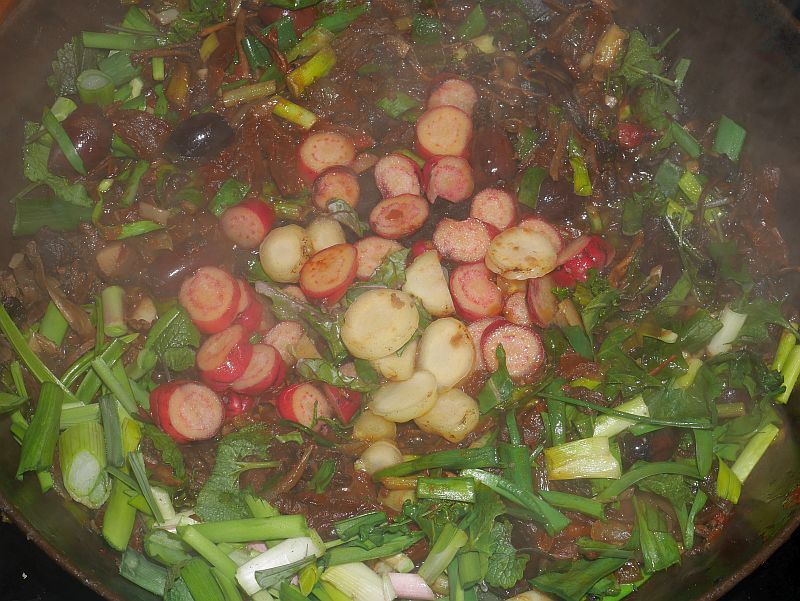A wonderful birthday dinner again this week!
As is the tradition since I left home, my birthday dinner has been Macaroni Cheese with rhubarb crumble for dessert. Mac Cheese was the first veggie dish I ate back in the 60s – Mum took us to Edwin Jones in Southampton (the superstore of the time) where they served it in the restaurant, sadly no more as Debenhams that took over closed for good last year during the first COVID lockdown… We loved it and it became a tradition for Mum to make this every Tuesday! Nowadays, we use whole grain spelt macaroni with masses of greens…Hablitzia or Caucasian spinach ( stjernemelde) and others (see this year’s list below).
Dedicating this once again to my dear Mum…it’s after all her 66th birth day too!
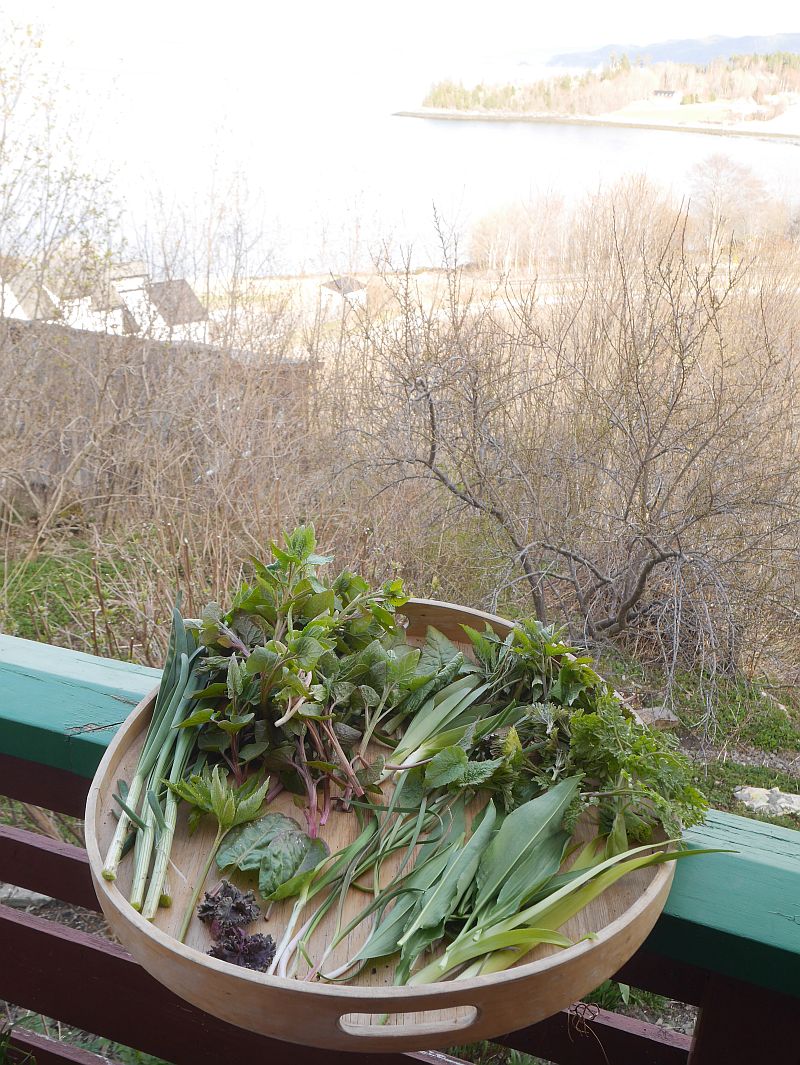


Ingredients:
Hablitzia tamnoides (Caucasian spinach / Stjernemelde)
Rumex acetosa (Common sorrel / Engsyre)
Rumex patientia (Patience dock / Hagesyre)
Ligularia fischeri (Fischer’s Ligularia / Koreansk nøkketunge)
Allium nutans
Aegopodium podograria (Ground elder / Skvallerkål)
Urtica kioviensis
Myrrhis odorata (Sweet cicely / Spansk Kjørvel)
Campanula latifolia (Giant bellflower / Storklokke)
Allium hymennorhizum
Dystaenia takesimana (Giant Ulleung Celery)
Rumex acetosa “Abundance” (Non-flowering sorrel)Allium cernuum (Nodding onion / Prærieløk)
Crambe maritima (Sea kale / Strandkål)
Allium ursinum (Ramsons / Ramsløk)
Allium sativum (Garlic / Hvitløk)
Hemerocallis dumortieri shoots.
Monthly Archives: April 2021
Unintentional presents
Yesterday was my birthday and the best presents were all unintended as birthday presents:
1. Allium victorialis from a large stand that has naturalised from a farm garden in Nordland county, Norway to be offered to various members of KVANN (Norwegian Seed Savers) when I get time (From Inger Elvebakk, who also took the picture):
2. A new sea kale / strandkål (Crambe maritima) accession from a KVANN member, from a wild population
3. Decorah Posten took over a month to get here, but it arrived too on my birthday (see https://en.wikipedia.org/wiki/Decorah_Posten); more about this another time!
Good times for gulls
The annual large flocks of gulls are now here resting in the bay after feeding following farmers’ ploughs all day. They are mostly common gulls (fiskemåke) and black-headed gulls (hettemåke). The field below the house was ploughed today as you can see in the film below. Other things to notice are the goat willows (selje), Salix caprea, now in flower at the beginning and I zoom in briefly towards a diver/loon (lom) in the bay.
Does udo resprout
During a webinar recently somebody asked me recently whether udo (Aralia cordata) resprouts in the same season if one cuts it. I said I would give photographic evidence that it does. The first picture is the blanched udo ready to eat. It was cut right down on 1st April. It reacted quickly by sending up two new shoots, one of which I ate and the second picture is what it looks like on 24th April (it was kept inside). So, the answer is yes that udo certainly responds quickly to us harvesting it.
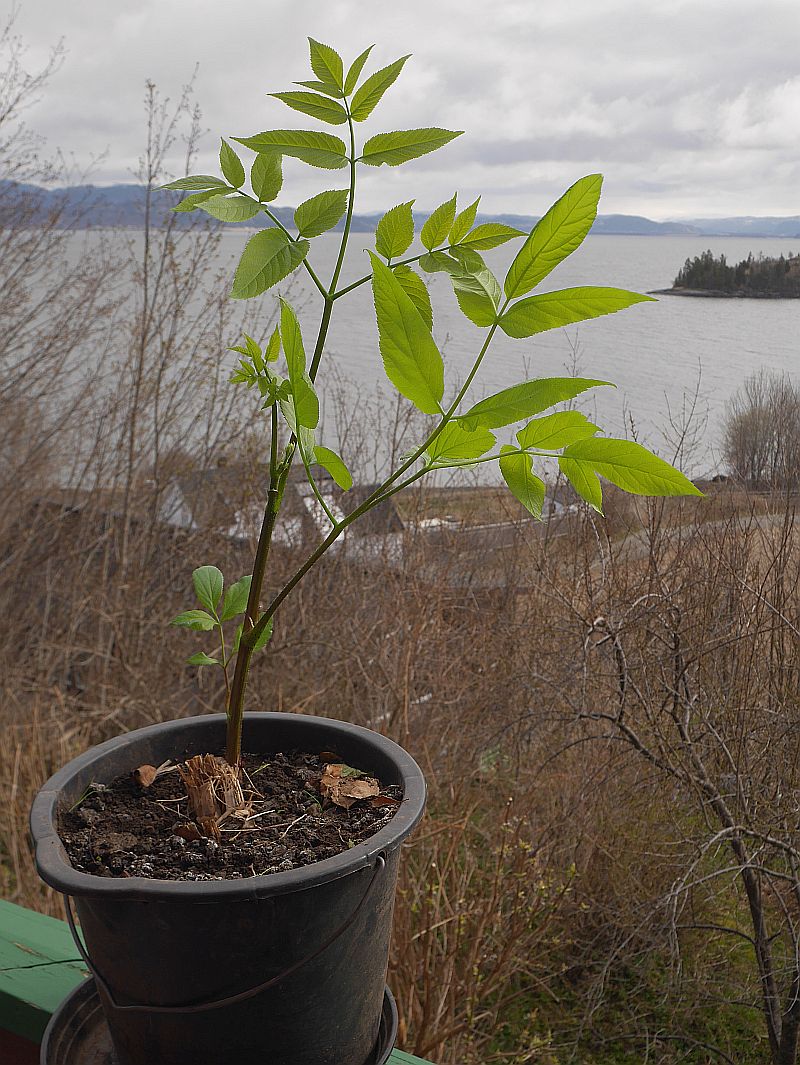
Perennial veggie saag and stuffed blue congo paratha
The favourite food of an average Englishman of my generation is Indian and I’m no exception.
Yesterday I was inspired to make perennial veggie aloo saag and stuffed blue congo whole grain paratha. It’s fun realising that it’s highly improbable that anyone has made this before!
First, here are the vegetables:
From top left: Ground elder / skvallerkål; two types of dandelion / løvetann; hedge garlic / løkurt; Ulleung giant celery (Dystaenia takesimana) (top right); (Bottom left) Allium hymenorrhizum; Welsh onion / pipeløk (Allium fistulosum); daylily / daglilje shoots; Siberian hogweed / sibirbjørnekjeks (Heracleum sibiricum); stinging nettle / brennesle; ramsons / ramsløk; common sorrel / engsyre (Rumex acetosa); Allium nutans; Catawissa onion / etasjeløk (Allium x proliferum); Victory onion / seiersløk (Allium victorialis); Mertensia ciliata; 2 Perennial kales / flerårige kål; Caucasian spinach / stjernemelde (Hablitzia tamnoides); Urtica kioviensis and Patience dock / Hagemelde (Rumex patientia) (Bottom right).
Next, potatoes were steamed on the wood stove and sliced into small pieces. The onions were fried with several cloves of garlic and then all the finely sliced greens were added and cooked gently adding the potatoes and assorted Indian spices (coriander, cumin, home grown golpar – ground seed of Heracleum – chili, salt and pepper with a piece of cinnamon stick and a few cloves). The greens release water so that no water is needed. This is the perennial veggie saag (there are many different saags made with different vegetables in India; see https://en.wikipedia.org/wiki/Saag
I chose to make the parathas using a 100% coarse wholegrain spelt flour which are difficult to make perfectly as they tend to fall apart, but I don’t care as they are tastier in my opinion! For the filling I used cooked and mashed blue congo potato with various spices and chili mixed in. Put a blob of the filling on the rolled out paratha, fold the dough over the filling and roll out carefully trying not to let the filling show through (it did).

You then dry fry both sides on medium heat, then melt ghee on the top, turn over and fry in the ghee for a minute and one more minute on the other side again and dinner’s served (Hope there are no Indians watching as I’ve probably broken all the rules, but the important thing it tasted fantastic: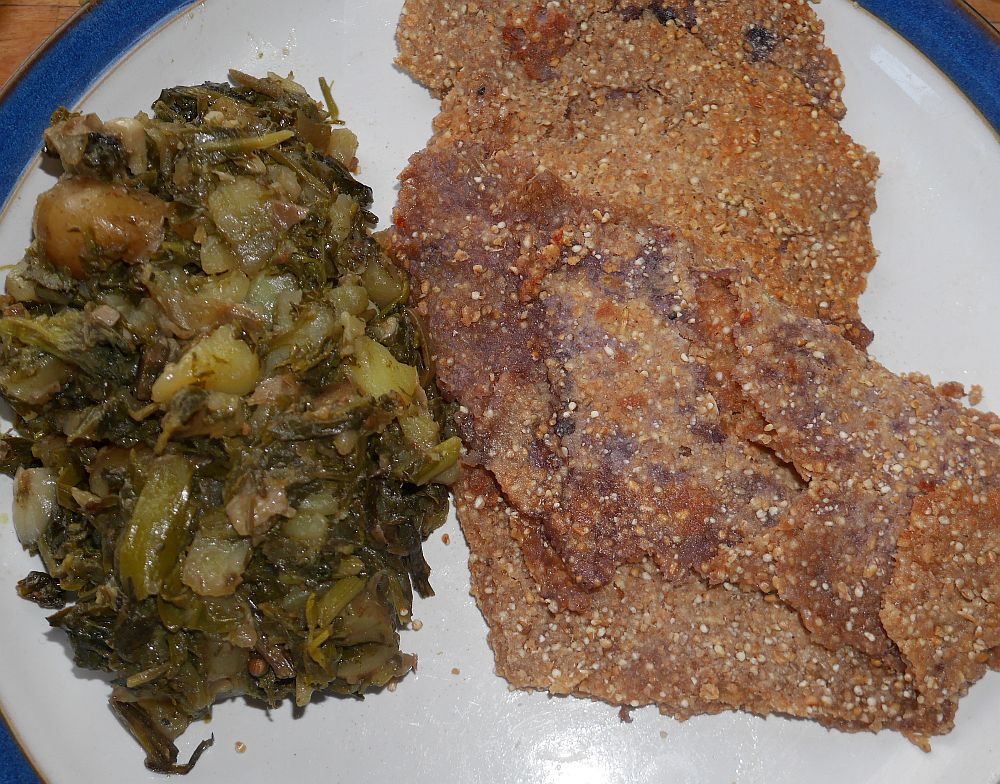
Habby pizza time with Urui shoots
We are now rapidly approaching maximum Habby (Hablitzia tamnoides) harvest, so most meals now have masses of shoots of this amazing perennial vegetable. We make sourdough bread every two or three weeks (it stores well) and usually make pizza with some of the same dough. 100% whole grain with zero refined flour of course. Yesterday, I collected a large bowl of Hablitzia shoots and also used Allium scorodoprasum and a few dandelion leaves for the year’s first Habbizza!
 The pizza was served with delicious raw urui (Hosta sieboldiana) with a roasted sesame seed / soya sauce dipping sauce:
The pizza was served with delicious raw urui (Hosta sieboldiana) with a roasted sesame seed / soya sauce dipping sauce: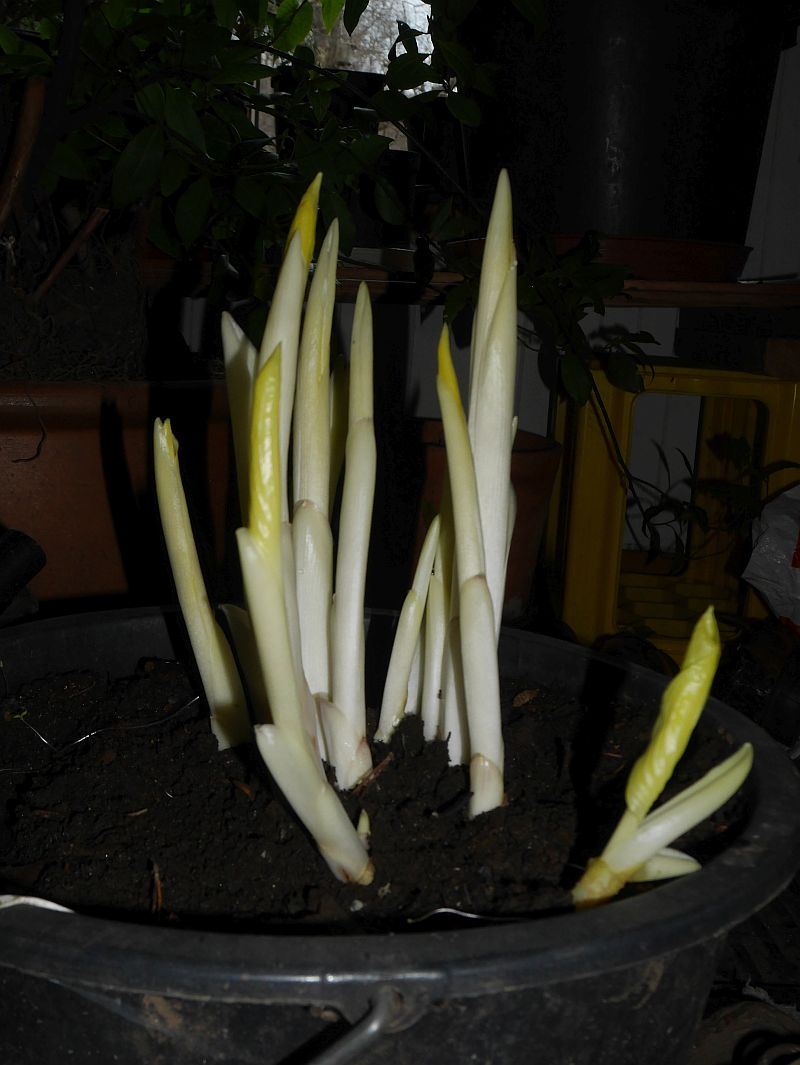

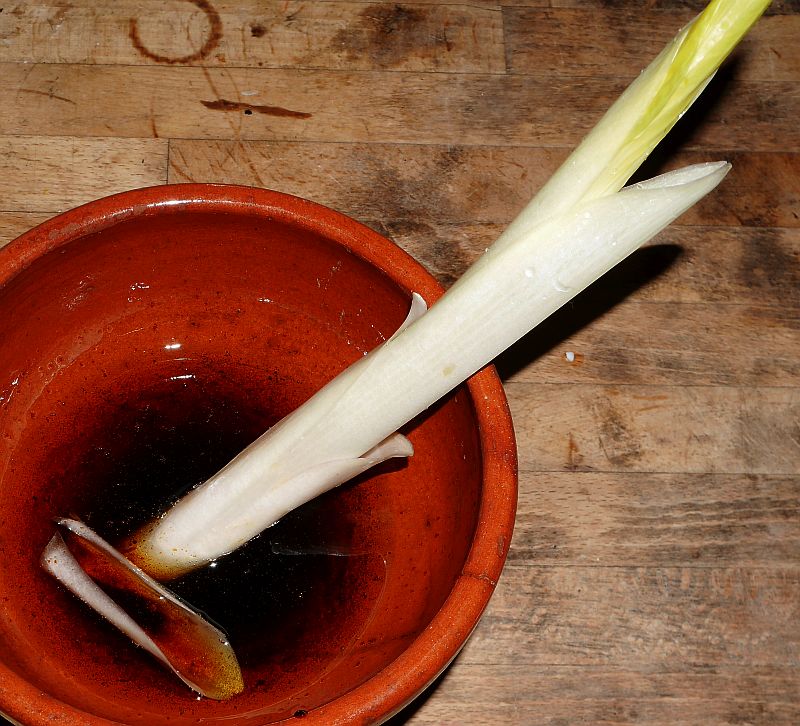
Habby pea soup
Yesterday was the first day above 10C this year and my Hablitzia (Caucasian spinach) plants are really growing fast. We used those in the picture together with thinned Allium scorodoprasum bulbs and shoots in a delicious home grown pea soup. 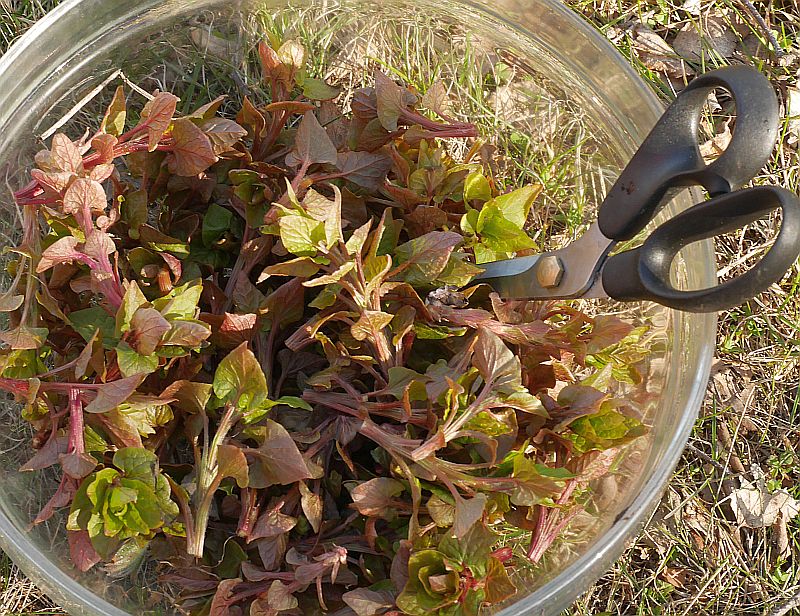

I’ll never tire of that view!
Woken at 5:58 am by the first rays of the sun and bird song as warmer weather has arrived at last.


First Garden Forage of 2021
Most of the greens are now finished in the cellar, so time for the first harvest in the garden despite for the fact that it’s been snowing off and on over the last week and air temperatures haven’t risen much over +5C so far this year: 30 different greens plus two varieties of oca made into a diversity green pasta sauce! SO GOOD! Lucky us being able to harvest the best nutrition straight from the garden with little effort. Perennials are best! As usual, the Giant Ulleung Celery (Dystaenia takesimana) has come on furthest of my perennial vegetables! See the list of species used below the pictures.
Species used:
Allium senescens
Allium x proliferum (shoots)
Hablitzia tamnoides
Primula elatior
Allium ursinum
Allium oleraceum
Allium cernuum
Allium nutans
Allium sativum (shoots)
Dystaenia takesimana
Mertensia ciliata
Tragopogon pratensis
Rumex acetosa
Aegopodium podograria
Urtica dioica
Allium paradoxum
Allium victorialis
Barbarea vulgaris
Allium x cornutum
Allium douglasii
Brassica oleracea (perennial kales)*2
Rumex patientia
Allium pskemense
Heracleum sibiricum
Hemerocallis dumortieri
Arabis alpina
Ficaria verna
Angelica archangelica “Vossakvann”
Allium cernuum
Laurus nobilis (inside)
Dissected dandelion bud
We’ve been eating dandelions for lunch every day now for almost 3 months from the roots dug in the autumn and there’s still loads (see my post in January and February here: https://www.edimentals.com/blog/?p=27183 and https://www.edimentals.com/blog/?p=27343). We basically cut at the base with scissors and yesterday accidentally dissected a flower bud! The dandelions will respond with new leaf and flower shoots.  Forcing pots of dandelions and other perennial vegetables in the living room; ease of access in what permaculturists call Zone 0
Forcing pots of dandelions and other perennial vegetables in the living room; ease of access in what permaculturists call Zone 0
 Dissected dandelion flower bud
Dissected dandelion flower bud



